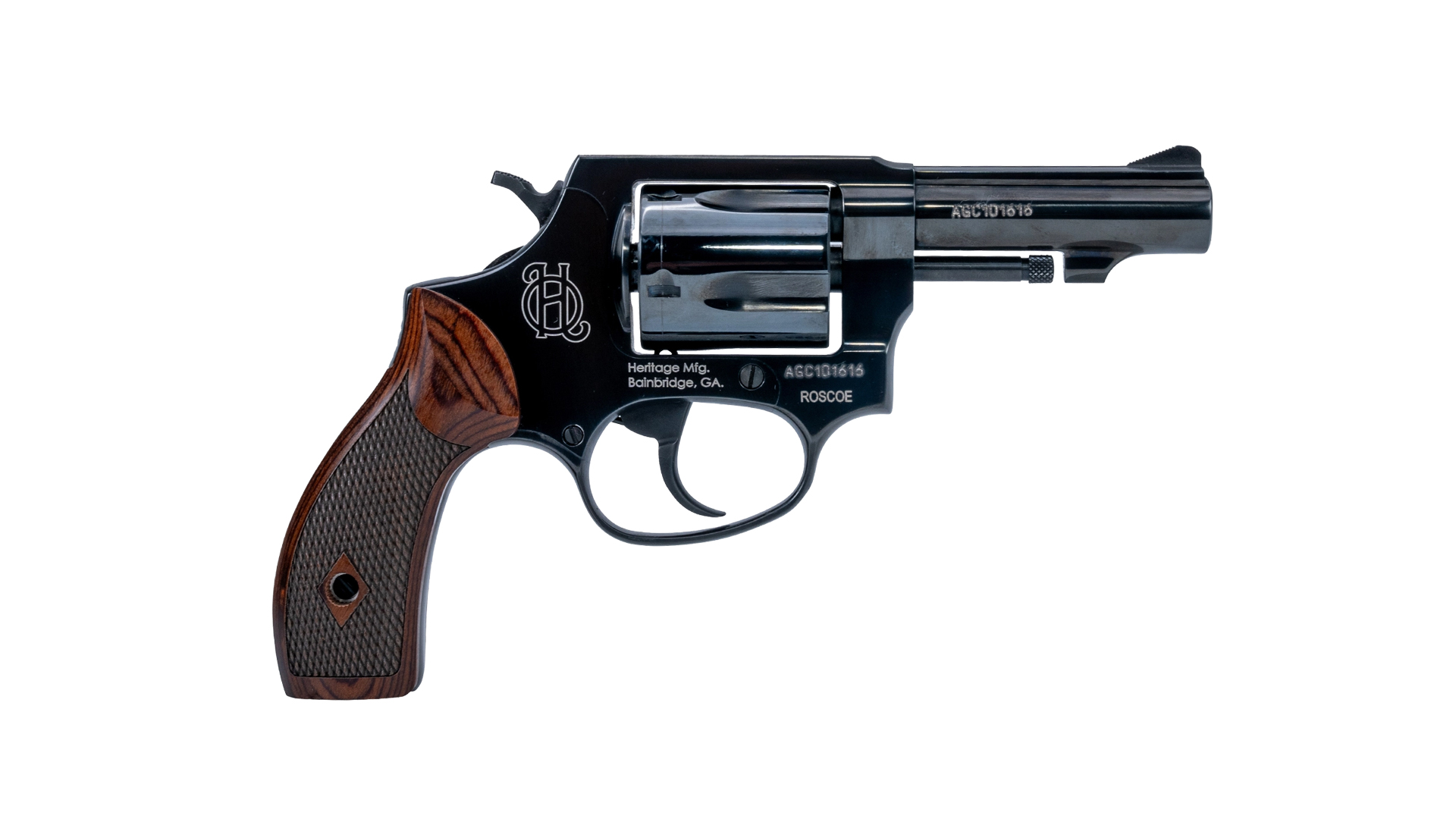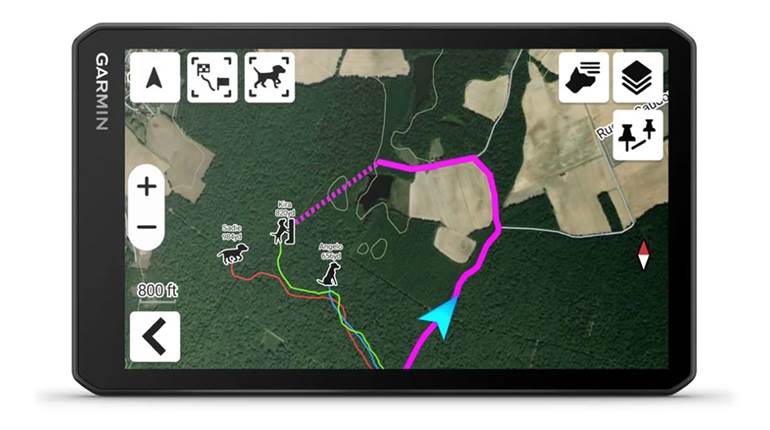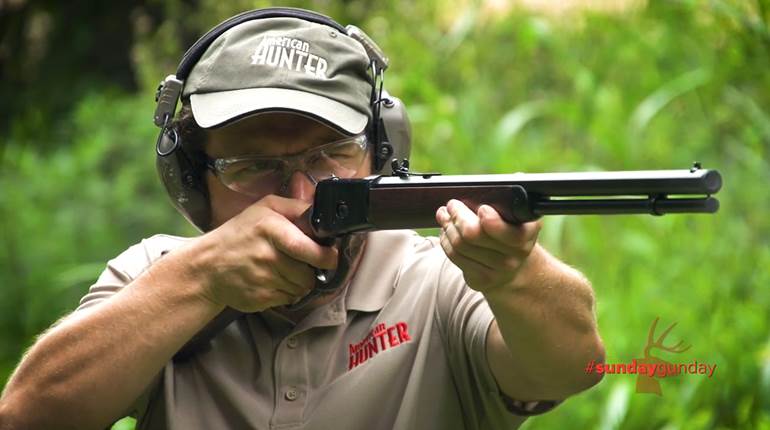
Roscoe (n.) – Early 20th century American English slang for a handgun. Now typically associated with vintage noir detective/private investigators and snub-nosed .38-caliber revolvers.
“That private eye keeps a Roscoe handy at all times, in case trouble comes looking for him.”

Taurus’ sister company, Heritage Manufacturing, which primarily offers Western-style single-action revolvers and lever-action firearms, recently delved into the 20th century with the introduction of its new Roscoe revolvers. Roscoe revolvers are based on the five-shot Taurus Model 85, and these guns recently made their first public debut at the May 2024 NRA Annual Meetings & Exhibits show.
True to the brand’s name, the new double-action Roscoes have a very traditional blued-steel and wood layout—something that has all but disappeared from gun shops’ display cases these days. With their looks, they’re reminiscent of the typical blued, compact double-action .38-cal. revolver that was commonplace throughout the 20th century. This appeal to "old-school cool" is what inspired the name Roscoe.

Heritage Mfg. Roscoe Overview
The Heritage Manufacturing Roscoe revolver is a five-shot .38 Spl. “round-butt” double-action revolver with an exposed hammer based on the Taurus Model 85. The Model 85 is Taurus’ foundational cornerstone for the rest of the Brazilian company’s compact-frame revolver lineup including the contemporary six-shot Taurus 856. Neither the new Roscoe nor the original Model 85 are direct clones of Smith & Wesson J-frames, but they do a good job of mimicking those vaunted classics from Springfield, Mass.
Overall, the Roscoe’s dimensions, their gist and the way they handle are inline with that of a vintage snub-nose. Like the Smith J-frames of old, these revolvers, too, have that same five-shot capacity, along with a cylinder that turns counter-clockwise. The lockwork’s internals are also not directly interchangeable, but anyone who knows revolvers could remove the Roscoe’s sideplate and pick up on the Smith-esque arrangement of parts. That’s probably not much of a surprise, given the history and influence Smith & Wesson had in Brazil.
Except for the topstrap and the top part of the barrel which have a matte/satin texture, all other metal surfaces including the cylinder have a shiny blued finish. True to their theme, the Roscoe’s wooden stocks have that old-time vintage styling albeit with a varnish finish instead of an oil-rubbed finish. Nonetheless, the Roscoe’s stocks do not look out of place whatsoever. Both stock panels are checkered, and I do appreciate the diamond motif around the screw-hole—it’s a tasteful nod to the Smith & Wessons of old.

The Roscoe’s action does make use of the more modern frame-mounted firing pin arrangement with a transfer-bar safety mechanism. These revolvers have non-shrouded ejector rods directly underneath the barrel and the end of the ejector rod sits free. Besides the cylinder stop, the cylinder and rod lock into place via the angled detent found on top of the yoke and from the rear of the inner frame.
Roscoe revolvers can be had with either 2" or 3" barrels, made from a single piece and included with a traditional 1:16" rifling twist that stabilizes standard .38 Spl. loads. These guns have fixed sights. Rear sights are milled directly through the frame’s topstrap, forming a channel, while their front sights are simple ramped-and-serrated affairs. The resultant sight-picture is very standard, with a square notch and square front blade.
Compared to my vintage Chief’s Special, the Roscoe’s sight picture is bolder and easier to see. Though revolver trigger pull could be subjective, my specimen’s trigger pull is fine. The double-action trigger pull breaks around 12 lbs. while the single-action pull averages out to 5 lbs., 9 ozs. Like with most other revolvers, the Roscoe’s trigger should improve with use as it wears in. A few drops of lubricant and much dry-fire has also been helpful.
The Roscoe At The Range
My Roscoe has a 3" barrel, which helps boost the muzzle velocity over the shorter 2" models. I tested four different loads through the gun—three of them officially for this review, plus my own handloads. These loads consisted of High Desert Cartridge Company’s relatively new .38 Spl. offerings, including the company's 148-grain plated, hollow-base wadcutter and its 125-grain TMJ rounds. Because this was modeled to be a traditional .38-cal. double-action revolver from the 20th century, it was only right that my third load be Federal American Eagle’s standard 158-grain lead round nose load–perhaps the archetypal .38 Spl. load.
From a rest at 7 yards, average group size hovered around .80" to .95". Shot dispersion wasn’t too dramatic between ammo types at this distance. While I had no .38 Spl. +P to test out, it’s worth noting that Roscoes can handle such cartridges.

For the review, I fired close to 150 cartridges. Roughly half of these were my personal handloads consisting of a Berry’s 158-grain flat-point bullet with 4.1 grains of HP38 (705 f.p.s.). At 7 yards shooting from rest, the point of impact for all loads tested landed an inch or two below the point of aim. At 10 yards, 158-grain loads seemed to shoot to the sights, or slightly just above. With my handloads, I was easily able to break the 10-ring of an NRA B-8 target with all but four of 20 rounds of my .38 Spl. handloads. Three of these are solidly on the 9-ring and the other was a tragic flier. From my experiences, I could infer that this revolver’s sights are regulated for 158-grain loads—once again, the classic .38 Spl. projectile weight. Besides shooting at targets and frequent-dry fire at home, I also practiced some defensive draws under a shot timer and a pocket holster. Unfortunately, the exposed hammer can snag on clothing, so it's best to shroud it with the thumb on the draw.
The Takeaway
Beyond 150 rounds I shot and the regular dry firing I’ve done with it, the Roscoe a solid unit, especially for its price. My chief complaint is the lack of profiling at the top edges of its stocks. During shooting, their sharp corners will bite the hand, which isn’t pleasant. I had to constantly change my grip to avoid their wrath. The extra material on the left-hand stock panel also seems to catch the rim of the cartridge-case closest to it when ejecting the empties; this happened nearly every time I swung out the cylinder to reload. Otherwise, the fit, finish and workmanship of the gun are quite good and free of any aberrations. In spite of its stocks and inherently undersized grip, I found the gun to be a good shooter with very decent accuracy.

My appreciation for the Roscoe is informed by the few vintage J-frame Smith & Wesson revolvers in my collection. These include a 1956 Chief’s Special (Pre-Model 36) along with a .22-cal. Model 34-1 Kit gun from the early 1970s. (Though not blued, my no-dash S&W 640 also gets an honorable mention).
Having a modern affordable stand-in that provides the look and feel of an old-school compact revolver is a good thing for all shooters. Finding specimens in good condition from yesteryear made by Colt or Smith & Wesson involves a good bit of money now; even the used models one used to be able to find in pawnshops—those days are history, too.
Today, any new unit that’s “shiny and blued” and sold by the "Big Three" American revolver manufacturers won’t be cheap, regardless of its frame size. Roscoes on the other hand, are shiny and blued, but more importantly inexpensive and available. And I think this is where their mirth lies. Both the 2” and 3” Roscoe revolvers have an MSRP of $363, but have a street price that’s close to the $300 mark. In 2024, and for that price, is there any other brand-new classically styled carry revolver that can evoke a near-identical user experience the same way a revolver built in mid-century could?

Heritage Manufacturing Roscoe Specifications:
Importer: Heritage Manufacturing
Action: double-action, centerfire revolver
Chambering: .38 Spl. +P
Frame: carbon steel, gloss-blue finish
Barrel: 3" carbon steel, gloss-blue finish
Rifling: six-groove, 1:16" RH
Cylinder Capacity: five
Sights: fixed rear, ramped front
Firing Pin: frame-mounted
Hammer: exposed
Stocks: hardwood
Safety: transfer bar
Overall Length: 7.50"
Width: 1.41"
Height: 4.80"
Weight: 23.52 ozs.




































